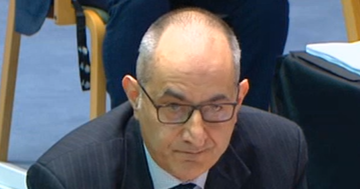
By Ian McAuley, University of Canberra
A supposition behind the Commonwealth’s Commission of Audit is that government has become “too large”.
The first paragraph of the Commission’s terms of reference sets the context, stating:
During this time [the last 20 years] the size of the Commonwealth government has expanded significantly, as has the remit of some of its activities.
It provides no support for this statement. In terms of what one would generally use as indicators of the “size” of government – receipts and payments – the evidence is lacking. See the graph below. Over the last 20 years there is no upward (or downward) trend. The variations in receipts and payments are what one would expect from governments applying counter-cyclical management through successive business cycles, while keeping the “size” of government roughly constant.

In fact, the Rudd-Gillard government had a specific objective of keeping taxation as a share of GDP below 23.7%, its level in 2007-08, and much lower than its peak of 24.9% in 2000-01. This objective was easily met because the GFC resulted in a sharp fall in tax revenue.
The inference from this preamble is that the Commission’s brief is to recommend spending cuts. It asks the Commission “to make recommendations to achieve savings sufficient to deliver a surplus of 1% of GDP prior to 2023-24” (my emphasis).
Although there are several references to “savings”, there is no requirement to consider the adequacy of public revenue, even though our taxation to GDP ratio at 26% (all levels of government) is the sixth lowest of all OECD countries and compares with an OECD average of 34%. Australia achieved this while running a much lower budget deficit than most of those countries.
If the Commission is to be professionally diligent, this constraint, along with those imposed by the government’s promises not to cut certain expenditures, gives it an almost impossible task, for it is also told to abide by the general economic principle that “government should do for people what they cannot do, or cannot do efficiently, for themselves, but no more”.
That’s a quite orthodox textbook principle for delineating the role of government in a market economy, which accepts that there are certain things that the private sector just cannot do (eg national defence) and that there are others which it could do, but only at greater cost, and possibly with inadequate coverage (eg roads, school education). While that delineation has a long history (almost the same words can be found in Abraham Lincoln’s speeches, it was formally codified in Samuelson’s 1954 paper “The Pure Theory of Public Expenditure”, which provided an economically rigorous framework around the theory of “market failure”.
In brief, that theory finds that public provision is the best option in many cases, not because private businesses are greedy, corrupt or inefficient: the theory does not rest on some “left” ideology. Rather, it is because some markets just cannot operate efficiently.
In some markets there is room for only one supplier (“natural monopolies”); in some it is impossible to exclude non-payers (the problem of “non-excludability”); in some with high sunk costs private provision results in the waste of underutilised capacity (the problem of “non-rivalry”); in some costs or benefits are imposed on or bequeathed to third parties (the problem of “externalities”). And there are many other areas where markets do not behave in line with the textbook theories of pure competition.
Finding the optimum division between public and private division is difficult. In fact, Samuelson reasoned that while there may be an optimum, it is conceptually and practically elusive. Some people get more benefit than others from collectively-provided goods (do you listen to the ABC?, how much do you drive on public roads?) and the forms of market failure are manifold. It is probable that Australia, a country with a high level of private consumption and a small public sector, errs on the side of under-provision of public goods.
So it is unlikely that the Commission, unless it takes a purely ideological interpretation of its task, will find too many potential savings without tipping that public/private ratio away from the optimum. It will undoubtedly find pockets of waste, duplication and areas where there is no market failure reason for public involvement (facilities for spectator sports come to mind), but if it is to do its job professionally it would almost certainly find areas where governments aren’t involved and should be.
The greatest constraint on the Commission, however, is its timeline, which specifies an interim report by the end of January and a final report two months later. That’s time for no more than a superficial survey and a ruined Christmas for the Commissioners and the secretariat. There is no time for the thorough processes undertaken by bodies such as the Productivity Commission and the Australian National Audit Office.
The Productivity Commission has a world-renowned reputation for its independence and professionalism. It has public hearings, which generally reveal the complexity of policy proposals and expose unintended consequences of superficially attractive ideas, and it issues public draft reports as a further check. It also produces an annual review on the effectiveness and efficiency of government service provision. The Audit Office undertakes ex-post evaluations of government programs, and is concerned not only with compliance, but also with efficiency.
Perhaps the best way the Commission of Audit can discharge its role, which includes consideration of duplication, is to point to the existence of these bodies of review and to wind up its own operations before incurring any public expense.
Ian McAuley does not work for, consult to, own shares in or receive funding from any company or organisation that would benefit from this article, and has no relevant affiliations.
This article was originally published at The Conversation.
Read the original article.





















